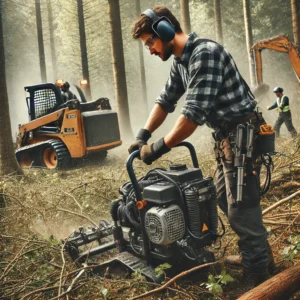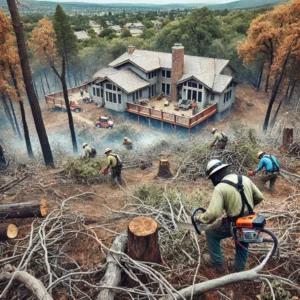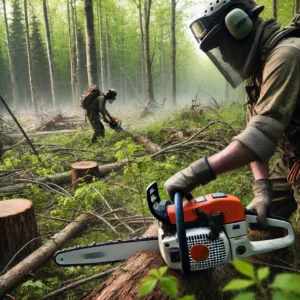Underbrush clearing is an essential process for land management, whether you’re preparing a site for construction, improving the health of a forest, or simply maintaining the aesthetic appeal of your property. Clearing underbrush, which typically consists of small trees, bushes, and other vegetation, offers numerous benefits, including reduced fire risk, improved accessibility, and enhanced landscape appearance. However, without the right tools and techniques, the task can become overwhelming. This guide will walk you through everything you need to know about underbrush clearing, from the tools you’ll need to the best practices for clearing land efficiently and safely.
What is Underbrush Clearing?
Underbrush refers to the vegetation that grows beneath the forest canopy, including shrubs, small trees, and other low-growing plants. Over time, this underbrush can become dense and tangled, making it difficult to walk through, navigate, or utilize the land effectively. In some cases, overgrown underbrush can also increase the risk of wildfires, as dead and dry vegetation acts as fuel for spreading flames.
Clearing underbrush involves removing this excess vegetation to create a more open, manageable, and safe area. This practice is commonly used in forest management, residential landscaping, and even agriculture. Whether you’re maintaining a wooded area, preparing for a new project, or simply trying to improve the health of your land, underbrush clearing is a crucial step in land management.
Why is Underbrush Clearing Important?
Underbrush clearing offers a variety of benefits, both practical and aesthetic:
- Fire Prevention: One of the primary reasons for underbrush clearing is to reduce the risk of wildfires. Dry, dead underbrush can act as a fire accelerant, allowing fires to spread more quickly and become more difficult to control. By regularly clearing underbrush, you minimize the amount of flammable material, significantly reducing the chances of a wildfire.
- Improved Land Health: Clearing underbrush can also benefit the overall health of the land. Overgrown underbrush can choke out native plants and trees, leading to an imbalance in the ecosystem. By removing the excess vegetation, you allow more sunlight, water, and nutrients to reach the healthier plants and trees, promoting growth and improving biodiversity.
- Better Access and Usability: Whether you’re managing a large forested area or a small residential lot, overgrown underbrush can limit accessibility. Clearing this undergrowth makes it easier to navigate your property, access key areas, and utilize the land for recreational or practical purposes.
- Aesthetic Appeal: Overgrown underbrush can make a property look neglected and unkempt. Clearing this excess growth not only makes the land more accessible but also improves its visual appeal. A well-maintained property is more attractive and can even increase property value.
Tools for Underbrush Clearing
The tools you choose for clearing underbrush depend on the size of the area, the density of the vegetation, and the specific goals of your project. Here are some of the most commonly used tools for the job:
- Brush Cutters: Brush cutters are powerful tools designed specifically for clearing thick vegetation, including small trees, shrubs, and dense underbrush. These tools come in various sizes and can be manual, gas-powered, or electric.
- Chainsaws: For larger areas or thicker vegetation, a chainsaw is a must. Chainsaws are ideal for cutting down small trees and clearing larger areas of dense brush. When using a chainsaw, safety is paramount, so be sure to wear protective gear, including gloves, goggles, and ear protection.
- Machetes: For lighter jobs or areas with thinner vegetation, a machete can be an effective tool for clearing brush. Machetes are versatile, easy to carry, and require no fuel or power, making them ideal for remote areas.
- Axes and Hatchets: If you’re dealing with thicker branches or small trees, axes and hatchets are indispensable. These tools are excellent for chopping down more stubborn plants and breaking through dense undergrowth.
- Tractors with Brush Hogs: For large properties or commercial clearing projects, a tractor with a brush hog attachment can quickly and efficiently clear vast areas of underbrush. Brush hogs are rotary mowers designed to tackle dense vegetation, making them ideal for fields and large lots.
- Rakes and Shovels: Once the bulk of the underbrush has been cleared, rakes and shovels can be used to clean up smaller debris and roots. This step helps to ensure the area is smooth, level, and ready for future use.
Techniques for Efficient Underbrush Clearing
Clearing underbrush can be labor-intensive, but with the right techniques, you can make the process more efficient and less overwhelming. Here are some tips for effective underbrush clearing:
- Plan Ahead: Before starting, assess the area and create a plan. Identify any obstacles, such as large trees or rocks, and determine the type of vegetation you’ll be dealing with. Having a clear plan will save time and ensure you have the right tools on hand.
- Start with the Largest Vegetation: Begin by cutting down larger trees or thick brush that’s harder to remove. This will make it easier to work on smaller vegetation without the larger obstacles in your way.
- Work in Sections: For large areas, it’s helpful to break the land into smaller sections and clear one section at a time. This method helps keep the process manageable and gives you a sense of accomplishment as each section is completed.
- Use Mulching Attachments: If you’re using heavy machinery, consider adding a mulching attachment. Mulchers break down the cleared vegetation into small pieces, which can then be left on the ground to decompose and enrich the soil.
- Safety First: Underbrush clearing can be dangerous, especially when using heavy machinery or tools like chainsaws. Always wear appropriate safety gear, including gloves, protective eyewear, and long sleeves. If you’re using power tools, ensure they are properly maintained and that you’re familiar with their operation.
Benefits of Regular Underbrush Clearing
In addition to the immediate benefits of reducing fire risk and improving land health, regular underbrush clearing offers long-term advantages:
- Enhanced Land Value: A well-maintained property with clear underbrush is more attractive to potential buyers, leading to higher property values.
- Better Wildlife Habitat: By clearing underbrush, you create a healthier environment for native plants and animals to thrive, promoting a more balanced ecosystem.
- Prevention of Pest Infestations: Dense underbrush can harbor pests like rodents, insects, and snakes. Regular clearing helps reduce these populations and minimizes the risk of infestation.
Conclusion
Underbrush clearing is a vital part of land management that improves safety, usability, and the overall health of your property. Whether you’re clearing a small backyard or managing a large forested area, the right tools and techniques can make the job easier and more efficient. By staying on top of underbrush clearing, you’ll enjoy a safer, more beautiful, and more valuable piece of land.
For more in-depth guides on property management and outdoor maintenance, explore other helpful posts at Scunderbrush.









